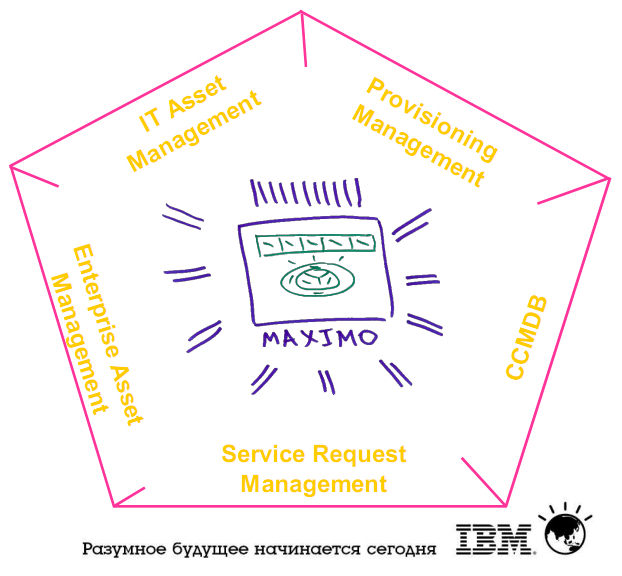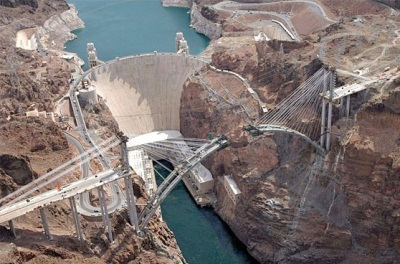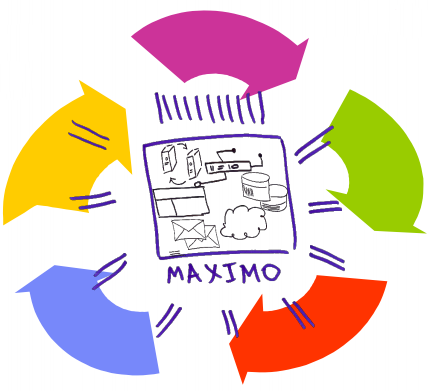Using Maximo platform, domestic experience

Last time, we talked about the theoretical part of physical asset management and, having promised to continue this topic with specific examples of Maximo integration at Russian enterprises, we gave only one example of how efficiently the system starts to work, where all the data is interconnected and the production chains no longer look separate links of the general chain, allowing us to understand both the cause and the effect, but what is much more important is to adequately respond to changing circumstances and factors.
But America is America. It is much more interesting to look at how Russian large enterprises, in fact - nationally significant, are introducing asset management systems, for what reasons and what, in the end, they get good.
Power sector
The optimal use of natural resources is an inexhaustible topic for discussion and work, it is hardly possible to achieve ideal and perfection in this area, but it is definitely worth striving for it.
 There is such a company in Russia - JSC Tatenergo, which includes almost all the main energy enterprises in the territory of Tatarstan. She is also controlled by the Generation Company, which operates six stations that were commissioned back in the 70s of the last century, and therefore, today, in need of timely repair, modernization or complete replacement of equipment.
There is such a company in Russia - JSC Tatenergo, which includes almost all the main energy enterprises in the territory of Tatarstan. She is also controlled by the Generation Company, which operates six stations that were commissioned back in the 70s of the last century, and therefore, today, in need of timely repair, modernization or complete replacement of equipment.For energy companies, repair and the simple equipment associated with it is a single issue, the wrong solution of which can lead to a drop in profits or, in extreme cases, a shutdown of electricity supply to consumers. Therefore, the solution to the problem of timely repair and maintenance, in fact, is key in optimizing the operation of enterprises such as the Generation Company.
The collaboration between IBM and Tatenergo began in 2008, when IBM experts conducted a pre-project survey of the companies controlled by the company and made recommendations on the implementation of the IBM Maximo platform. With the help of two IT companies: TatAISenergo and OTR, which acted as a software integrator, the preparation phase was launched, at which it was necessary to collect all the valuable information on repair, equipment replacement and any other data related to repair and maintenance, in digital form. At the enterprise, which for decades kept all the data on paper, this turned out to be a truly non-trivial task, which took a lot of time and effort.
The work itself was divided into three parts: A. Analysis of system design, on the basis of which the terms of reference were created; B. Implementation of the basic functionality for accounting equipment, its location, defects, repairs, supply of resources and, of course, setting up software and its integration with the Parus information management system that was already operating at that time. Then the platform was installed at the facilities of OJSC Generating Company.
In order to understand how much this is a large amount of work, it should be added that these steps took three years to complete. During this time, much has been done: information on past repairs and replacements is collected in electronic form, and for current tasks it is delivered primarily in this (digital) form - this allows you to track certain trends and expect what will happen in the predicted future. Thanks to these actions, the Generation Company today has a methodology for assessing defects and a complete picture of technological interconnections.
In general, the introduction of the Maximo platform at an enterprise of this scale is a unique experience in domestic practice. Today the system provides the following functionality in full:
- Equipment Lifecycle Management
- Repair and maintenance, reconstruction and replacement work planning
- Order management, incl. material and technical resources and personnel
- Management of production warehouses and production personnel
- Maintenance of technological schemes of work in accordance with standards and norms
- Presentation of analytical information on the current state of assets
- Providing a unified system for managing workflow
The last, third stage, continues to this day and includes the introduction of the rest of the system’s functionality: from work planning and integration with other information and analytical systems used in the company, to the development of KPI indicators that can dynamically describe the overall system performance.
However, the main stage, namely, the presentation of critical information on the repair and condition of the equipment, has been passed. Therefore, today in the “Generating Company” they can boast that they keep their finger on the pulse of what is happening at each individual enterprise, since the data from it falls into a single information system.
Hydropower
Another positive example from the Russian energy sector is the company RusHydro, which hardly needs to be introduced - it is the only hydro-generating company in Russia and one of the largest in the world whose total capacity reaches almost 23 GW.
 The Maximo platform was implemented at nine sites on the Volga and Kama, in three time zones, and the goal of integration was to increase the company's competitiveness. In electricity production, competitiveness is the reduction of downtime while increasing production volumes. Parallel factors here are increasing the reliability of the equipment, its degree of availability and durability throughout the company.
The Maximo platform was implemented at nine sites on the Volga and Kama, in three time zones, and the goal of integration was to increase the company's competitiveness. In electricity production, competitiveness is the reduction of downtime while increasing production volumes. Parallel factors here are increasing the reliability of the equipment, its degree of availability and durability throughout the company.Prior to the implementation of Maximo at RusHydro facilities, each facility used its own system based on tabular sheets, with the help of which the state of the equipment was monitored. Today, this is perhaps one of the most obsolete accounting systems, sometimes still used by large enterprises, and its main problem is that it covers only a small part of the processes. In addition, it is a paper-based accounting system, which means that historical data is voluminous and stored in classical archives, which are difficult to categorize, systematize, or compile in any other way.
Well, when each of the nine hydropower plants has its own, independent, inventory of reserves, this leads to the fact that the company, as a single organism, suffers from uncoordination. And at RusHydro, almost 25% of the inventory units were ordered from suppliers, although they were available at other facilities for free. You can continue for a long time ...
As a result, RusHydro asked six integrator companies to show their ideas on how to optimize this process and, after carefully examining the proposals put forward, chose an integrator, Bellwood Systems, which introduced the IBM Maximo platform at nine hydropower plants on the Volga and Kama.
In addition to increasing reliability and availability, as well as the service life of the equipment, the company now has the opportunity to plan repair work and orders that were scheduled for years ahead by using Maximo software at the same time and smoothly . At any time, a couple of clicks you can get an action plan for the technical support of systems and equipment, which will increase the time between outages and, ultimately, reduce the total repair time, along with its cost.
As for data accounting and key production indicators, now the chief engineers receive daily automatically generated reports for all open orders, with a list of possible problems and information on the current status of the process. No need to go around all the objects - just turn on the computer. Breakdown response time is now reduced to a minimum, and critical objects can quickly return to working condition. In general, RusHydro speaks of a 30% reduction in the volume of outstanding repair work - a good result.
The next step is the implementation of the Maximo platform at all facilities owned by the company - these are 49 power plants throughout Russia.

Pipe rolling
We also talked about the “Height 239” pipe-rolling workshop in a separate post , but not to turn this unique Maximo implementation experience here does not turn a hand.
Actually, it was at "Altitude 239" that the potential of the Maximo system was tested in real conditions and its compliance with the requirements put forward by ChelPipe with respect to software products. For IBM and the Chelyabinsk Pipe Rolling, this is a positive experience. Specific numbers can be found by clicking on the link, here I will only note that if products of this level were used in every workshop and every factory, then there would be no mention of any problems with repair or critical condition of the equipment.
Banking sector
Delta Bank JSC, together with IBM, introduced a collateral management system based on the Maximo platform. The reason why the bank needed a unified information system of this level is simple - in 2010, the bank’s loan portfolio was significantly expanded by transferring part of the accounting assets and liabilities of Ukrprombank LLC to its accounts. These are large loans to enterprises, consumer loans, car loans and so on.
For 35 days, Delta Bank deployed a unified information system based on Maximo software, which allows to increase the level of control over the management of collateral property and improve discipline in the process of monitoring collateral agreements and their execution.
In addition, many business processes of credit services were automated: registration of collateral, management and control of insurance and collateral contracts, sending out notifications, checking property, managing insurance cases, closing collateral, and so on.
The main criteria for creating this system for Delta Bank were performance and reliability. Since part of the data was imported from the banking system used at that time, it was important to use modern methods for seamless integration. IBM Maximo easily integrates with any automated banking systems, including the main “Delta Bank” ABS B2 system.
By the way, the history of cooperation between Delta Bank and IBM has been going on for several years - it all started in 2006, when the bank began using the company's software: Lotus Domino, AIX, Message Broker and TSM.
Metallurgy
 There is a company in Germany called SMS SIEMAG - it manufactures equipment for the steel industry and is part of the large SMS Gmbh holding. In particular, the equipment of this company is also used at Russian metallurgical facilities.
There is a company in Germany called SMS SIEMAG - it manufactures equipment for the steel industry and is part of the large SMS Gmbh holding. In particular, the equipment of this company is also used at Russian metallurgical facilities. With the help of the EAM Systems integrator (who helped integrate Maximo in the Height 239 workshop), IBM formed a fruitful collaboration with the SMS concern and now IBM software, in particular the Maximo platform, manages the planning and organization of maintenance work for the continuous casting machine ( CCM) supplied by SMS Siemag. Thanks to Maximo, it was possible to optimize maintenance and repair, reduce the frequency and downtime of this expensive equipment, not to mention the reduction in emergency and overtime.
In addition to directly monitoring the operation of the machine, Maximo software is used for warehouse accounting of spare parts and materials for repairs, automatically notifying those responsible about the need for some work or urgent repairs.
The presence of such a strong partner as SMS in the IBM customer portfolio speaks only about one thing - Maximo is trusted all over the world, regardless of the area in which optimization is required - it is realizable. At the same time, increasing performance indicators and reducing the expense item of repairs.
